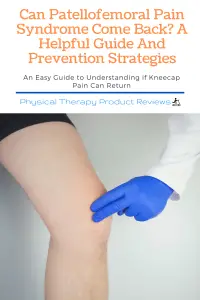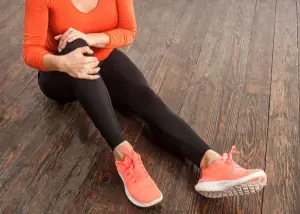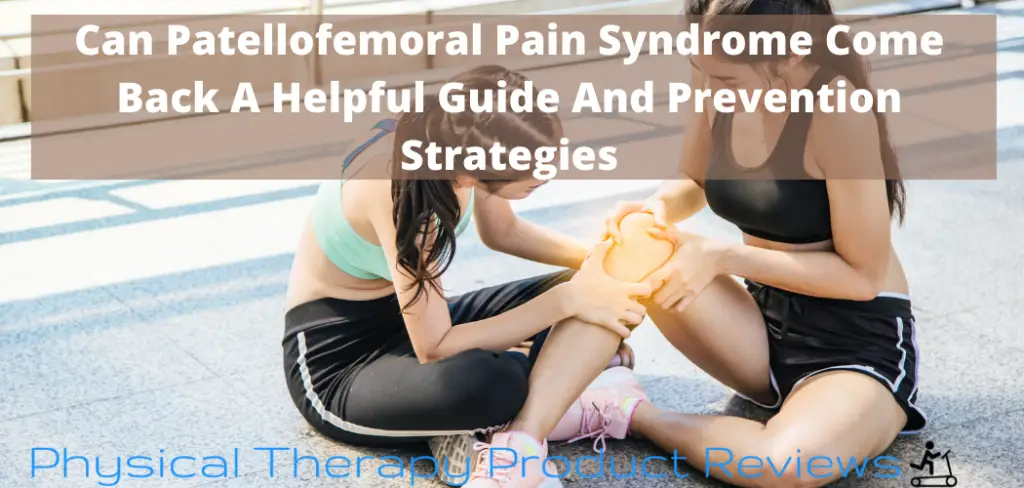Do you experience Patellofemoral Pain Syndrome (PFPS)? Is it coming back again and again like a bad dream? If this is the case, then we want to help.
Patellofemoral pain can be frustrating because it tends to linger. Some things bother it, and then some activities don’t hurt at all.
This blog post will review what patellofemoral pain syndrome is, what causes it, and how to prevent it from returning.
Can Patellofemoral Pain Syndrome Come Back?
Yes, Patellofemoral pain can come back and more quickly than most people would like. Even once you feel fully healed and are back to normal, it can take just one activity to bring that similar pain back.
This is because even though you feel better and less pain, the soft tissue is still easily irritated and most likely not back to baseline. So you might be just below the pain threshold and don’t notice it during most activities, but it doesn’t take much to take you back over that pain threshold.
Strength deficits in the quad and hips take up to 3 months to build enough strength to take pressure off the kneecap during activities.
This lack of strength is a large reason why patellofemoral pain seems to return quickly for some people.
What is Patellofemoral Pain Syndrome?
 The patellofemoral joint is the point where your kneecap glides over your Femur. It can be one of the most painful joints in our body, especially regarding patellofemoral pain syndrome (PFPS).
The patellofemoral joint is the point where your kneecap glides over your Femur. It can be one of the most painful joints in our body, especially regarding patellofemoral pain syndrome (PFPS).
PFPS occurs when there is excessive pressure between the bone and cartilage on this joint. This can cause irritation on the fat pad and surrounding soft tissue, resulting in pain during activity and specific positions.
This can happen for several reasons, including muscle weakness and imbalance around the knee, overuse injuries from exercise or sports, patellar malalignment (kneecap misalignment), and previous injury to the patella tendon.
What Causes Patellofemoral Pain Syndrome?
As you can see, patellofemoral pain syndrome has many causes. Some of the most common include overuse injuries from exercise or sports (running is especially hard on your patellofemoral joints), excessive stress to the patella (from a sudden increase in training intensity, resistance training with poor technique), and muscle weakness and imbalance around the knee (quadriceps and hamstrings imbalances).

Patellar mal-alignment makes it so the patella doesn’t sit correctly on the Femur, and it may put more pressure on the bony prominences. This increases pressure and stress in those areas, which in turn will increase your risk of developing patellofemoral pain syndrome and can eventually even potentially lead to patellar arthritis if is not treated properly.
Does Patellofemoral Pain Syndrome Go Away?
Yes, patellofemoral pain syndrome can go away. The average length of time for PFPS to heal is anywhere from 6 weeks to 3 months; however, in some instances, it can last as long as 9 months in certain situations.
There are many ways to treat patellofemoral pain syndrome, depending on the underlying cause of your condition.
This can include:
- patellar taping
- patellofemoral braces to reduce poor tracking (kneecap misalignment)
- orthotics or knee-stabilizing insoles for correcting patellar malalignment
- icing the patellofemoral joint after activity
- proper warm-up before exercising
- patellofemoral exercises to strengthen your quadriceps and hips muscles
Is Patellofemoral Pain Syndrome Permanent?
No, patellofemoral pain syndrome is not permanent, although it might feel like it will be permanent in some instances.
It may be hard at first to find the cause of your patellofemoral pain and treat it because there are so many possible causes for this condition. However, start by consulting with a physical therapist or other health care professional. They can help you pinpoint what is causing patellofemoral pain and then help you develop a patellofemoral pain syndrome treatment plan that works for your specific case.
Is Patellofemoral Pain Syndrome Permanent?
No, patellofemoral pain syndrome is not permanent, although it might feel like it will be permanent in some instances.
It may be hard at first to find the cause of your patellofemoral pain and treat it because there are so many possible causes for this condition.
However, start by consulting with a physical therapist or other health care professional. They can help you pinpoint what is causing patellofemoral pain and then help you develop a treatment plan that works for your specific case.
How Can You Prevent Patellofemoral Pain From Coming Back?
There are many prevention strategies that you can use to help ensure patellofemoral pain does not come back after you have successfully treated it.
Do not stop all activity! This can make it worse and increase muscle activity. Simply reduce or modify pain-causing activities and temporarily change to new painfree activities.
Reduce or Modify Aggravating Activities
The most critical factor is reducing or modifying aggravating activities. If the kneecap is continually getting aggravated then it makes it challenging to heal all the way. Aggravating factors for PFPS typically including:
- running
- squatting
- prolonged sitting
- stairs
- biking
Strengthen the Quad and Hips for Kneecap Pain Prevention
Strengthening the quadriceps and glutes can help prevent patellofemoral pain syndrome by taking some of the load off your patella and the surrounding soft tissue.
The stronger your quads and hips are, the more the pressure is appropriately placed in the muscles as you squat and bend the leg, and the less the pressure is in the knee cap and bony structures.
You can see our helpful post on strengthening exercises for patellofemoral pain syndrome here at this link.
Conclusion
Patellofemoral pain syndrome can come back, but you can do several things to help prevent it from coming back.
First, start by consulting with a physical therapist or other health care professional who specializes in patellofemoral pain treatment so they can help you pinpoint what exactly is causing your condition and then develop a patellofemoral pain syndrome treatment plan that works for you.
Second, reduce or modify aggravating activities to patellofemoral joints and lower limbs (knees). Thirdly, strengthen your quadriceps muscles and glutes with appropriate patellofemoral pain exercises.
Other Great Physical Therapy Related Articles
How to Stay Active After Cervical Fractures: Expert Tips and Advice
Dealing with Painful Stairs After Ankle Replacement Surgery
Walking After a Total Ankle Replacement: Tips for a Successful Recovery
Exercises While Non-Weight Bearing After Ankle Replacement: Elevation, AROM, Leg Raises, and More
Ankle Pain with Stairs: Causes and Home Treatment Options
5 Common Mistakes You’re Making After an Ankle Sprain
Disclaimer: The information provided in this post is for educational purposes only. This is not a substitute for a medical appointment. Please refer to your physician before starting any exercise program.







